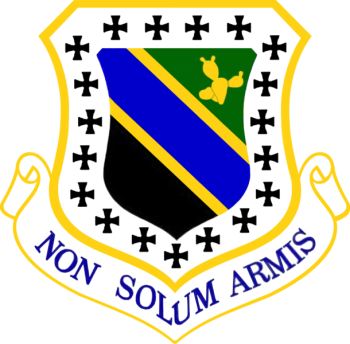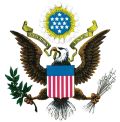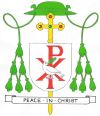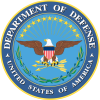3rd Wing, US Air Force
3RD WING, US AIR FORCE
History: Established as 3 Bombardment Wing, Light on 10 August 1948. Activated on 18 August 1948. Redesignated as: 3 Bombardment Wing, Tactical on 1 October 1955; 3 Tactical Fighter Wing on 8 January 1964; 3 Wing on 19 December 1991. Trained as a bombardment and reconnaissance wing prior to Korean War. Performed reconnaissance and interdiction combat missions from Iwakuni AB, Japan, at the beginning of the Korean War, 1-19 July 1950. From 20 July to 1 December 1950 the tactical group and its squadrons served under operational control of another organization. The wing assumed a supporting role, initially from Johnson AB, Japan, but later from Yokota AB, Japan. The Wing returned to Iwakuni AB on 1 December 1950, regained control of its combat units and performed night intruder combat missions. Moved to South Korea in August 1951 and interdicted main supply routes in western North Korea for the remainder of the war. After the Korean War, the wing participated successively in bombardment, air defense, reconnaissance, and air refueling training. Its headquarters was non-operational 1 September 1963 to 8 January 1964. Moved to the United States without personnel or equipment in January 1964, then trained and rotated its squadrons in detached status to Southeast Asia for combat duty. Moved in November 1965 to Bien Hoa AB, South Vietnam, a forward operating base, which frequently came under enemy mortar and rocket fire. Missions included close air support, counterinsurgency, forward air control, interdiction, and radar-controlled bombing. Supported numerous ground operations with strike missions against enemy fortifications, supply areas, lines of communication and personnel, in addition to suppressing fire in landing areas. During this time, wing also participated in combat evaluation of F-5 and A-37 aircraft. Unmanned and unequipped on 31 October 1970, the wing remained active in a “paper” status until it moved to South Korea on 15 March 1971, to be manned and equipped with F-4 aircraft. In September 1974, moved without personnel or equipment to Clark AB, Philippines, replacing the 405 Fighter Wing. Participated in frequent operational exercises and evaluations. Between 5 April and 31 May 1975, wing used its facilities as a staging area for Operations Baby Lift (evacuation of Vietnamese orphans from South Vietnam to the United States) and New Life (evacuation of Vietnamese adults to the United States for resettlement). Performed fighter aggressor training operations using T-38 and later F-5E aircraft from 1976 to 1988; deployed throughout Pacific Air Forces to provide dissimilar aircraft combat training to US and allied fighter units. Deployed aircraft from the Philippines to Korea annually to participate in multinational joint-service combined forces exercises, 1978–1991. With addition of the F-4G “Wild Weasel” aircraft in 1979, the wing acquired dual role capabilities of air-to-air/air-to-ground and defense suppression/electronic countermeasures. Assignment of the 1 Special Operations Squadron, equipped with MC-130 aircraft, provided the wing with an unconventional warfare capability, January 1981-March 1983. Operated UH-1N helicopters, 1988-1991, for drone recovery, VIP airlift, range support, Philippine air defense site support, and medical evacuation. At the end of May 1991, the last F-4 aircraft departed the wing, shortly before the eruption of Mount Pinatubo in June 1991. Wing was not operational from June 1991 until it moved on paper to Elmendorf AFB on 19 December 1991, replacing the 21 Tactical Fighter Wing. Expanded the air defense mission of Alaska with the F-15E aircraft to include deep interdiction and air-to-air capabilities. Added an airlift mission in April 1992 and a long-range airborne surveillance, detection, identification, and command and control mission in 1993. Since 1993, deployed and employed assigned aircraft worldwide to accomplish air superiority, air interdiction, tactical airlift, airborne air surveillance, theater resupply, passenger service and served as host unit for all Elmendorf AFB organizations. During 2004, fulfilled Air Expeditionary Force (AEF) taskings in support of Operations Enduring Freedom and Iraqi Freedom.
Official blazon
Party per bend vert and sable in chief a cactus (prickly pear) or, a bend azure fimbriated of the third, all within a bordure argent charged with nineteen crosses patee of the second.
Origin/meaning
The shield is divided diagonally into the original colors of the Air Service, green and black. Over the dividing line is a band of the Air Force’s, present colors, ultramarine blue and golden yellow representative of the Rio Grande River dividing the US and Mexico. On the green field is a yellow cactus commemorating the group’s first patrols along the Mexican border. Around the shield is a white border with black German crosses equal to the number of aerial victories credited to the Group’s original squadrons during the Great War (World War I). Approved on 22 December 1952; newest rendition approved on 1 October 1998.
Literature:Image from Wikimedia Commons. Information from https://www.afhra.af.mil/
US heraldry portal
This page is part of the US heraldry portal |
Heraldry of the World |
|
US heraldry:
|
Ecclesiastical Heraldry of the USA:
Military Heraldry: |
Contact and Support
Partners:
Your logo here ?
Contact us
© since 1995, Heraldry of the World, Ralf Hartemink 
Index of the site















